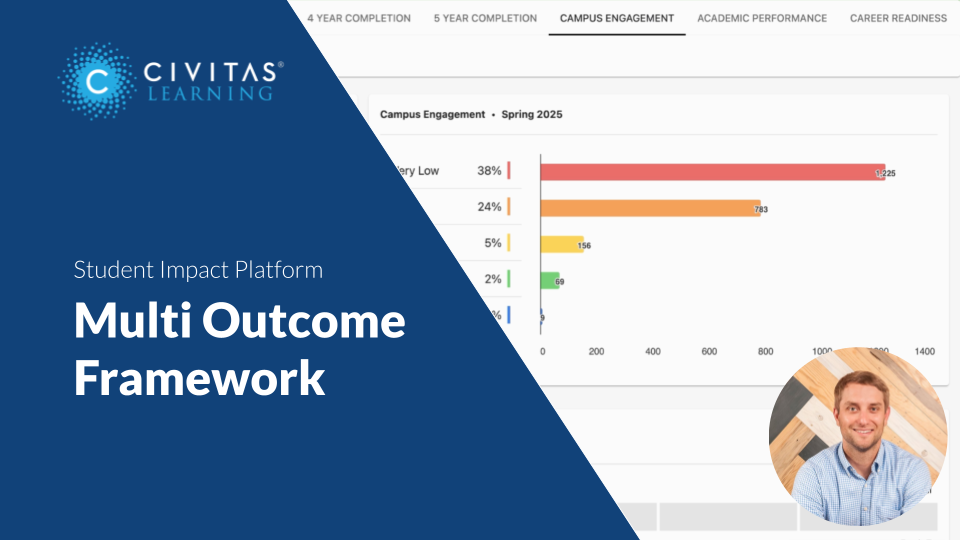
Why Student Data Quality Matters & 5 Steps to Improve It
Share this Post
In today’s higher education landscape, creating a successful student experience means seeing the whole student—not just their academic performance. Insights help teams create tailored support plans, but many institutions find it difficult to access quality data.
The reliability of student data and an institution’s ability to use it can create significant barriers to success. If the information is inaccurate, it can mean missed chances to help students and lead to unnecessary spending on policies and programs that don’t work. This ultimately limits the institution’s ability to make informed decisions that actually improve outcomes. The good news is that there are several proven strategies to enhance data quality and drive better results:
2. Implement Data Validation and Cleansing
3. Enhance Data Integration and Centralization
4. Leverage Data Analytics and Visualization
5. Foster a Data-Driven Culture
What’s Preventing Higher Education from Having Student Data Quality?
Institutions have access to a wealth of data to support students—often using anywhere from 50 to 200 systems—but much of this information is scattered across various repositories and formatted in ways that confuse analysis. While many institutions are eager to leverage their data to improve student outcomes and achieve their goals, several obstacles stand in their way:
- Lack of Stakeholder Buy-In — Department leaders must align on using data to drive decisions. Longstanding methods of managing data in silos make it difficult for faculty and administrators to agree on common data sources and shared dashboards.
- Fragmented Data — Siloed or inconsistently formatted data makes it difficult to identify trends, patterns, and roadblocks and can hide opportunities to improve outcomes for specific student groups. Outdated or incomplete data further complicates efforts to support students effectively.
- Limited Access to In-Term Performance — While final grades and course credits offer valuable insights, they arrive too late in the term to allow for timely interventions. Real-time insights are needed to provide effective and timely support.
- Outdated Systems — Legacy systems often aren’t created for easy collaboration, complicating data quality management. Department leaders often see the data they collect as their own instead of shared resources, which creates obstacles to effective information sharing.
Five Strategies for Improving Data Quality
There’s a growing recognition that academic leaders need to use data and analytics to guide strategic decision-making. The Chronicle of Higher Education reported that 97% of college administrators surveyed believe that higher education needs to use data and analytics to drive better decisions.
So, how can schools access clean, usable data? Here are five effective strategies to help teams achieve this goal:
- Establish Data Governance
The first step to obtaining quality data is implementing the right systems and policies to support it. This approach ensures that data remains consistently clean and well-organized for collaboration. These standards, known as data governance, are crucial for building trust in the protection and security of student information while also helping teams make better decisions.
To establish strong data governance, organizations need to focus on processes, culture, and the goals they want to achieve. When departmental staff sees the data they collect as their own instead of shared resources, it creates barriers to effective information sharing. Encouraging regular collaboration between teams helps drive meaningful change. It makes a more data-driven mindset, allowing everyone to access and understand how to use the data in their specific roles.
As Northwest Missouri State University (Northwest) worked to improve retention rates, it recognized that faculty and staff needed a centralized location to communicate and access student data easily. By investing in technologies that streamlined workflows and provided actionable student insights, they were able to deliver comprehensive support at scale, resulting in an 8% increase in retention between 2016 and 2021.
- Conduct Data Validation and Cleansing
Once the right structure is in place, it’s crucial to clean the data of issues like missing, duplicate, or erroneous entries. Regular data validation helps maintain accuracy, but these audits can be time-consuming for Institutional Research teams. Partnering with an analytics provider experienced in data cleansing and validation can simplify this process. Institutions can seamlessly pull data from systems like the SIS, LMS, and CRM, allowing them to work from one centralized source and reducing errors and confusion caused by manual reporting.
The University of Texas San Antonio (UTSA) has established a framework where senior leadership and all academic support units understand how their roles contribute to student success. In adopting a data-driven model, they collaborated to determine which data to include and regularly discussed insights to take meaningful action.
Transforming raw data into high-quality insights is a game changer for making decisions that affect student success. Whether addressing a financial hold or advising on course enrollment, UTSA knows that every interaction impacts the student experience. Their data-driven student support ecosystem has led to significant improvements in retention, with a 16% increase from 2012 to 2022.
- Enhance Data Integration and Centralization
It’s widely recognized that a student’s life outside the classroom significantly impacts their success, yet many institutions lack the context needed to provide effective support. With data spread across various sources, integrating student information into a consistent format makes insights accessible to all relevant stakeholders. This integration includes notes, alerts, reports, course history, communications, and analytics like persistence likelihood and engagement opportunities.
A complete view of a student’s experience should be included in their profile, equipping students, faculty, and advisors with the accurate insights necessary for informed decisions. Administrators can examine reports detailing staff interactions with students, including meetings, communications, and notes, allowing them to adjust their efforts to better meet student needs.
It’s also crucial to remember the essential role that human expertise plays in maintaining data integrity. Insights generated from any solution should enhance this expertise, not replace it. For example, Slippery Rock University (SRU) effectively drives proactive student success using institution-specific analytics integrated into connected workflow tools. They identified that Exercise Science majors with a GPA of 3.0 or lower and 45 earned hours were less likely to persist.
This insight prompted the student success team to form a dynamic group to monitor these students, connecting them with career resources and support when their performance fell below a certain threshold.
- Leverage Data Analytics and Visualization
Raw data alone doesn’t offer the insights needed to drive better outcomes. Technology can bridge this gap by utilizing predictive models tailored to your institution, transforming raw student data into actionable insights. Institution-specific predictive models deliver more relevant information for refining strategies than insights based on national demographic trends. Real-time insights, including engagement and behavior metrics, can be segmented and shared, allowing teams to implement effective approaches that enhance the student outcomes that matter most.
With access to real-time data presented through intuitive dashboards and reports, leaders can continuously monitor performance and proactively support students. Rather than waiting until the end of the term or relying on Institutional Research for reports and visualizations, they can make timely adjustments that help students thrive and reach their full academic and personal potential.
Features like filtering and drill-down options offer valuable context for decision-making, enabling teams to take action where it matters most. Additionally, clear visual representations of data enhance collaboration across departments, which is increasingly vital as institutions strive for fiscal responsibility and transparency in their decisions.
Actionable analytics helped Snow College assess the effectiveness of its advising program and maximize its limited advising resources. Using the Civitas Learning platform’s initiative analysis capabilities, they discovered that 1:1 advising led to a 20% increase in persistence for students at higher risk of not continuing. In comparison, high-performing students saw only a 3% improvement. With this insight, they optimized resources by providing 1:1 advising to higher-risk students and offering group advising to those at lower risk, enabling better support without additional advisors.
- Foster a Data-Activated Culture
Analytics are only valuable when leaders and departmental leads know how to apply them daily. When data is effectively managed and validated, it plays a crucial role in guiding higher education professionals as they decide how to tailor their support for students. This helps address two key areas:
- Students — When institutions can accurately identify and target students’ needs, they can deliver proactive support to improve outcomes at scale. Data quality significantly influences stakeholders’ confidence in their efforts and can impact student success.
- Programming — By integrating data into discussions, institutions can strategically allocate resources for the future and evaluate pilots and initiatives throughout the term.
Proper training is essential to achieving a data-driven culture. It helps users understand the analytics and empowers them to take action based on what they see. Some institutions, like Austin Community College, have developed programs offering ongoing training and videos that go beyond the typical one-time training session. These resources let users stay updated on new features and learn how other departments leverage analytics.
While the sheer volume of available data can be overwhelming, centralizing information from different sources and validating it for accuracy is essential for improving decision-making and achieving better outcomes. As institutions look to the future, consistently analyzing and leveraging this data will be crucial.



